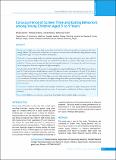Please use this identifier to cite or link to this item:
https://hdl.handle.net/20.500.14356/936| Title: | Co-occurrence of Screen Time and Eating Behaviors among Young Children Aged 5 to 9 Years |
| Authors: | Sharma, Bimala Shrestha, Nirmala Koirala, Sharad Tiwari, Bishnu Raj |
| Citation: | SharmaB., ShresthaN., KoiralaS., & TiwariB. R. (2023). Co-occurrence of Screen Time and Eating Behaviors among Young Children Aged 5 to 9 Years. Journal of Nepal Health Research Council, 20(3), 617-622. https://doi.org/10.33314/jnhrc.v20i3.4055 |
| Issue Date: | 2022 |
| Publisher: | Nepal Health Research Council |
| Keywords: | Children Co-occurrence Energy dense food intake Fruit vegetables intake Screen time |
| Series/Report no.: | ;4055 |
| Abstract: | Abstract Background: High screen time, high energy dense food and low fruits and vegetables are important risk factors among children. The study aimed to find out co-occurrence of screen-time and unhealthy eating behavior among young children aged 5 to 9 years in Pokhara Metropolitan. Methods: A cross-sectional study was conducted among children. Face to face interviews were done with 352 parents of the selected children. The study was conducted from March to October, 2020. High screen time was defined as >2 hours screen viewing each day; low fruit vegetable defined as <3 servings a day; and ≥ one serving a day of energy dense food was categorized as high consumption. Results: Out of total, 33.0% did not met recommendation for single health behavior, 38.9% did not meet for two and 23.9% did not for three health behaviors; and 62.8% had two or more risk behaviors. Of total, 19.6% had low fruit vegetable and high energy dense intake, 17.0% had high screen time and low fruit vegetable, 2.3% high screen time and high energy dense and 23.9% had high screen time, high energy dense and low fruit vegetable. Proportion of co-occurrence of multiple risk behaviors was higher among those whose parents had higher screen time, offered screen devices to them; and the children who had television and television cable at home, and had personal screen device (P<0.05). Conclusions: About two-third children had multiple risk behaviors; proportion is higher among those who had access to screen devices and higher parental screen time. It may require a combination of efforts to improve healthy behaviors. Keywords: Children; co-occurrence; energy dense food intake; fruit vegetables intake; screen time. |
| Description: | Original Article |
| URI: | http://103.69.126.140:8080/handle/20.500.14356/936 |
| ISSN: | Print ISSN: 1727-5482; Online ISSN: 1999-6217 |
| Appears in Collections: | Vol 20 No 3 Issue 56 july-Sep, 2022 |
Files in This Item:
| File | Description | Size | Format | |
|---|---|---|---|---|
| 4055-Manuscript-30766-1-10-20230314.pdf | Fulltext Article. | 239.05 kB | Adobe PDF |  View/Open |
Items in DSpace are protected by copyright, with all rights reserved, unless otherwise indicated.
